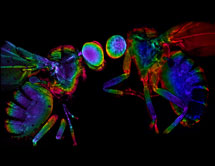UAB Imaging Lab Explores Science in HD
By Grant Martin
Melissa Chimento has seen the face of the enemy, and that enemy looks like—a finger. Chimento, a UAB alumna, is an electron microscopist in UAB’s High Resolution Imaging Facility (HRIF), a technology-packed lab in the Shelby Biomedical Research Building that offers researchers the chance to see their work up close and personal, even when the object of their attention is thousands of times smaller than the diameter of a human hair.
 |
A male (right) and female fruit fly are shown at more than 75 times their size by using laser confocal microspy. To view this and other images from the HRIF, scroll down and click the arrows in the slideshow below. |
At the controls of an FEI Tecnai T12 TEM, Chimento has captured images of anthrax, adenoviruses, and Mycobacterium tuberculosis, the potentially lethal bug that causes tuberculosis—looking remarkably fingerlike (and quite nonthreatening) in its native environment.
Each year, hundreds of researchers pay a visit to the HRIF, says Kent Keyser, Ph.D., who directs the facility and UAB’s Vision Science Research Center. Vision researchers are regular users of the lab’s equipment, which includes two electron microscopes and several high-powered light microscopes, but its users also include scientists from the Comprehensive Cancer Center, Rheumatic Disease Core Center, Hepatorenal Fibrocystic Disease Core Center, Cystic Fibrosis Center, Biomatrix Engineering and Regenerative Medicine Center, and many others, Keyser notes. These centers also provide monetary support for the facility, Keyser adds, “which is critically important in helping keep fees low while maintaining a high standard of service.”
Seeing Is Believing
Researchers come to capture details of cellular processes and to take advantage of the HRIF’s ability to create two- and three-dimensional reconstructions and animations and record time-lapse video, among dozens of other applications. The devices necessary to do this “are all very expensive, so placing the equipment in a shared core facility ensures that it is accessible to scientists from all different labs across campus, as well as scientists from other universities and institutions,” explains HRIF microscopist Shawn Williams.
(Story continues below slideshow)
“In the old days, we were restricted to morphology—looking at the size and shapes of cells,” says Albert Tousson, a former lab manager of the HRIF, now retired, who still works for the facility as a consultant. “Now we can do so much more. We can look at the relative levels of protein expression or protein interactions or cell dynamics. That’s why people come to our lab, to actually get to see a digital manifestation of what they’re finding through other disciplines.”
Images acquired at the HRIF aren’t just for the researchers’ benefit, however. “Scientists often need their images to grab attention, whether it’s to help their research get published or to convey information more clearly,” notes microscopist Ed Phillips. “Complex techniques are necessary to acquire specific types of images, and that often takes time.”
Painters of Light
In order to highlight key areas of their images, microscopists use techniques such as immunofluorescence to bring color and contrast to the monochromatic world of cells. “The color is most often imparted by employing antibodies tagged with fluorescent dyes, which emit light at different wavelengths,” Tousson explains. “The tagged antibodies bind specifically to cell proteins, and we reveal the pattern of those proteins by using different colors for each one.”
In another technique, known as pseudocoloring, a digital color palette is used to colorize samples based on the varying intensity of light emitted in different regions of the image. “The brightest compartments are assigned one color, and the dimmer compartments get other colors,” Tousson says.
Coloration is often scientifically necessary, but it is also where the artistry of a microscopist comes into play. While most of the images acquired by the facility are for use by the researchers who requested them, microscopists sometimes choose their own subjects to test new techniques. Tousson’s images of plant walls, fruit fly wings, and other cellular close-ups are miniature masterpieces of form and color. They earned him several high rankings in the international Nikon Small World Photomicrography Competition, the Super Bowl of light microscopy, which has celebrated the artistry of exceptional scientific imaging for three decades.
“To be selected, micrographs have to show scientific value, but they are also judged on how arresting the image is,” Tousson explains. “I had several that placed in the top 20, but I always wanted to get in the top 10. As I was getting ready to retire from UAB in 2008, I was honored as employee of the month, and on that same day, I found out that I had made it to third place.”
Night and Day
Tousson hasn’t left his self-described “posse” at the lab for good. In his role as a consultant for the HRIF, he helps patrons interpret experimental data and offers them detailed explanations of complex imaging techniques. “The personal reward is being able to participate in the melding of minds to arrive at a cooperative resolution to a project and the sense of accomplishment after resolving a stubborn problem.”
Despite the fact that they work with more than 150 faculty members and an even higher number of graduate students, it is that cooperative, patron-centric approach that distinguishes the HRIF, says microscopist Ed Phillips. “Some professors are very independent; they know exactly what they want from an image and just need help with the hardware. But in many labs, the scientists are working on very specialized projects and just don’t have the time to learn how to acquire the images they need. In those cases, we can either teach them or simply acquire the images for them. They spend a small amount of money for a tremendous service.”